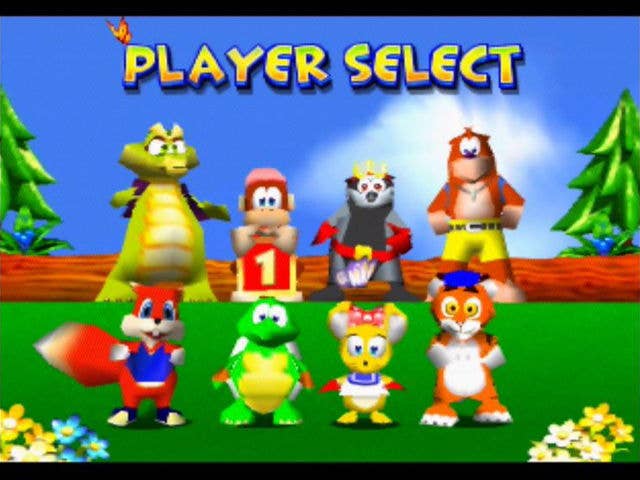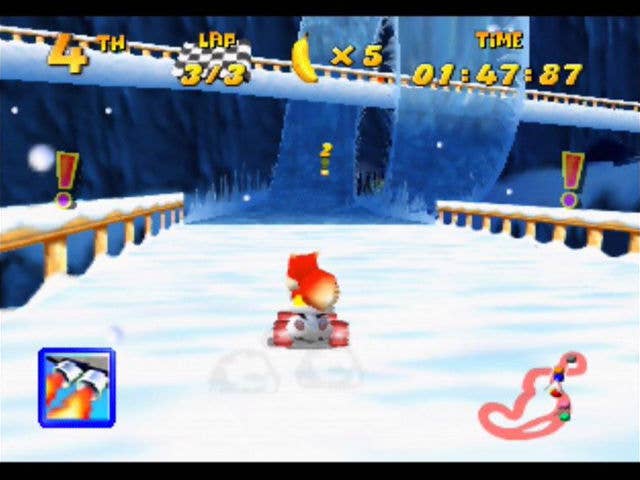Diddy Kong was my Dark Souls
Sumo Digital's Jamie Smith says Rare's N64 kart racer left the competition in the dust
Why I Love is a series of guest editorials on GamesIndustry.biz intended to showcase the ways in which game developers appreciate each other's work. This edition was contributed by Jamie Smith, senior game designer at Sumo Digital.
"...it's better than Mario Kart"
- Controversial '90s gamer
For me, Diddy Kong Racing (DKR) reflects the pinnacle of high quality UK game development in the mid-to-late '90s and proudly stands in my top 5 games of all time even today. More specifically, it's an archetypal title that also helped cement Rare as one of the best studios in the world. Preceded by GoldenEye and succeeded by Banjo-Kazooie, DKR was one of many fantastic games that compared favourably to their Japanese counterparts, and in an era where hidden gems were abundant. It was safe to say that anything Nintendo could do, Rare could do better.

Firstly, there is a strong cast of characters and this is testament to the creativity and originality of the team: Donkey Kong's nephew, an evil warthog, a chipper squirrel, and a clumsy bear (both titular characters in their own right shortly after) were just a fraction of the playable cast. But how can anyone forget the level of fondness for Tiptup and Pipsy? They were clearly overpowered but that wasn't to the detriment of the game's balance. Though I fondly remember the "fastest-finger-first" metagame played by me, my dad and my sister on the character select screen, with the loser blaming their inevitable defeat on having to pick any of the other quirky characters with inferior attributes. But that was also the beauty of the game. I can recall daring myself to do a lap in reverse before challenging for first position to keep things interesting - a change in playstyle inspired by many suggestions in N64 magazines of that time to keep things fresh.
Then there was the game world itself, Timber's Island, a hub-and-spoke environment that was typical of platforming games around that time, except it was applied to a racing game instead. The hub is the central starting area where the player is able to become accustomed to the controls without fear of failure, and the spokes are a series of themed levels which are accessible through any of the many doors scattered around the world and propose a series of race challenges to complete. Even now, I still find that a pretty unique design decision as it was one of several precursor approaches to the modern open world genre.
Each of the island's regions were fairly diverse and accompanied by an upbeat soundtrack that adapted to your location. Still, in order to get around you had to first frantically beep at Taj, the resident elephant genie (of course), to grab his attention and transform your vehicle into a car, airplane or hovercraft. I was blown away by the sense of freedom enabled by this ability as inaccessible collectibles were often teased behind obstacles, secret locations were unveiled through exploration, and what other game disguises a bonus character as a squishable frog that splashes around near the waterfalls? Genius.
This sense of mystery was also consistent throughout adventure mode, the core progression path. Keys and amulet pieces were littered throughout each of the tracks that would grant access to new content, but this was only after having completed the silver coin challenge; a great addition that significantly increased the difficulty of a given race. Each of the game's unorthodox boss characters proposed that eight coins must be collected, in addition to winning a race, before further progress could be made. However, the initial test was to actually seek out the coins as they were placed in awkward positions away from the optimum racing line.
This was probably the first time I remember being absolutely hooked on such a simple challenge, replaying it over and over until perfection was achieved or blisters had set in. Weeding out the muscle memory I'd gained from almost mastering the time trials, I hammered each race over and over, constantly scouring for shiny loot. And what happened when I finally did manage to acquire them all? Well, then I had to make up for lost racing time as the AI had ramped up several gears from the previous encounter, too. This pressure was further compounded by the fast-paced music played throughout the final lap. Unfortunately for me, even 20 years after first picking it up, I never did quite manage to unlock the elusive TT character - that was a challenge too far for my tenderised digits.
If it hasn't sunk in by this point, I'll put the game in context: a wealth of playable avatars with differing attributes, a uniquely structured game world promoting freedom and exploration, a variety of mysterious secrets waiting to be discovered, a series of memorable boss encounters, a level of difficulty unlike anything else within the genre, and a limited amount of guidance provided throughout. Make no mistake, this was my Dark Souls.

Outside of playing games, I think DKR was the first time that I truly became aware of brand loyalty, much less a disciple of it. It bought so much credit with me that I continue to buy Rare products even to this day and I don't even own an Xbox! The same natural affinity can be said for those associated with Playtonic Games and Free Radical Design, offshoots of the original Rare dev teams. There are names associated with each of these studios that instantly trigger an impulse purchase and I know I'm not alone in saying that I've been fortunate enough to meet a couple of my heroes throughout my time working in games. I'm thankful to both the individual and collective developers involved in creating this masterpiece as it definitely pushed me towards being a designer within the industry today.
Still, speaking as such, I'm eager to see more investment and experimentation in the karting genre outside of Nintendo's platforms. Sure, there's inevitably going to be a new Mario Kart but it would be nice to see a contemporary take on the original hub-based formula, inspired by recent successes from games outside the karting subset. This is especially apparent in the excellent Forza Horizon series which humbly began with a world cordoned off by boundaries before iteratively transitioning into a fully open world. There's also been some good ideas scattered throughout unsung heroes from the previous console generation such as: F1 Race Stars, ModNation Racers and LittleBigPlanet Karting. But special praise has to be reserved for Sonic & All-Stars Racing Transformed, as it's probably my favourite karting game since DKR, for many of the reasons listed above. (Editor's note: 2012's Sonic & All-Stars Racing Transformed was a Sumo Digital-developed game. Smith only began working at Sumo Digital earlier this year.)
I'm convinced there's a market salivating at the prospect of franchise innovation and it's good to see the recent Unreal 4 DKR remake and the Disney Infinity 3.0 Toy Box recreation further supporting this notion. One day though, maybe I'll get the chance to pay homage to those that inspired me.
Praise the mon(key)...
Upcoming Why I Love columns?
This is normally where we plug our upcoming columns, but as of this writing, we don't have any. We would love to keep this a regular feature on the site, but we can't do it without help! Developers interested in contributing their own Why I Love column are encouraged to reach out to us at news@gamesindustry.biz.
